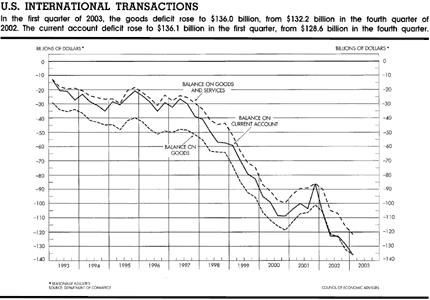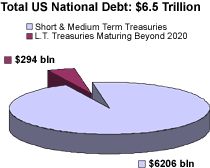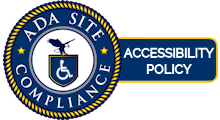| As of November 4, 2004 | ||
| Index | YTD % Change | Market Value |
| Dow Jones Industrials | -1.33 | 10,314.76 |
| S&P 500 | +4.47 | 1,161.67 |
| Nasdaq Composite | +1.01 | 2,023.63 |
There has been a significant decline in investor expectations over the past several weeks. The presidential election, price-fixing in the insurance industry, product recalls in the pharmaceutical industry and record high oil prices have been pressuring stock prices. We have gone above and below the 10,000 level on the Dow Jones Industrial Average several times this year. Surprisingly Treasury bond prices have shown a significant amount of resilience as investors in the equity markets moved to the sidelines. Crude-oil futures had crossed the $55 a barrel level, which is the highest point since oil futures started trading on the New York Mercantile Exchange in 1983. Rising oil prices can seriously hurt equity valuations over time as investors begin to fear higher energy costs, weaker corporate profits and lower consumer confidence.
Among Mr. Bush’s most ambitious domestic economic goals is additional income tax code reform. The President is expected to study ways to make the system less complicated and move it more toward a tax on spending, as opposed to income. He also wants to make permanent the tax cuts passed in his first term. The pressure to amend the tax code partly comes from the unpopular Alternative Minimum Tax provision that exists in the present code. Any significant tax-reform plan will be very controversial and hard fought in the Congress. We are optimistic that Congress will pass a rational energy bill that would benefit energy investments. We also believe that a meaningful tort reform bill has a chance of passing in the Congress, and this could have a broad benefit to the financial markets.
The first half of the year’s surge in job growth increasingly looks like an aberration. The hurricane season certainly did not help the situation in the third quarter, but The Bureau of Labor Statistics believes the effect of the storms will ultimately be small relative to the overall job growth picture for the entire year. The economy is still moving forward, but slower than expected as we indicated in our last Outlook. The strain on the U.S. economy from rising oil prices is a further risk to GDP growth in 2005.
The Federal Reserve Board is likely to stay “measured” in raising interest rates. We interpret “measured” to mean quarter-point steps are still the basic plan, with periodic pauses. December remains the best chance for a pause before year-end. We assume a 2% federal funds rate at the end of 2004 and 3.5% by the end of 2005. Core CPI inflation might inch up to around 2% by year-end. Given our GDP growth expectations, the risks associated with higher inflation are probably low. Our 2005 forecast for GDP remains at 3.5%, but high energy prices could significantly reduce that number. Obviously higher gasoline prices and home heating fuel costs could push total CPI inflation up and GDP growth down next year.
Unlike the period in the 1990’s when excess oil producing capacity was 5 to 10 million barrels per day at a time when worldwide oil demand was 72 million barrels a day, at the present time demand is approximately 82 million barrels per day and maximum capacity is considered to be approximately 83 million barrels per day. In 2005 the expectation is that oil demand will increase again and may even exceed current production and refining capacity.
In the meantime summer and fall inventories of crude oil, gasoline and heating oil have been drawn down, and they will probably not fully be built back in time for the winter heating season. Furthermore, refinery capacity and shipping capacity is fully utilized leaving no room for supply interruptions. Oil companies continue to justify capacity expansion on $25 a barrel oil, which suggests that supplies could remain tight for a considerable period of time.
The degree to which the exchange rate of the dollar will maintain its present level depends on foreigners’ willingness to reinvest these funds back into the United States. It is worth noting that in July net private purchases of U.S. treasury bonds and notes fell to $18.3 billion from $23.0 billion, and in August net private purchases of U.S. treasury bonds and notes swung to a negative -$4.4 billion from a positive $18.3 billion. Moreover, in July private net cash inflows into the U.S. were $73.8 billion and in August it declined to net cash inflows of only $37.4 billion. This represents approximately a 50% decline. Making up the short fall were dollar purchases from foreign central banks. Should the foreign exchange value of the dollar decline further, we can expect an improvement in our current account deficit if imports slow and exports increase. However it seems reasonable to assume that we can still expect a further devaluation of the dollar. Should this occur we would expect rising prices for precious metals, commodities, collectibles and imported goods.
The current price of energy, gold and industrial raw materials as well as overall market trends corroborate our view that equities representing “hard assets” offer some of the best opportunities for investors. The future earnings, cash flow and dividends from the companies we like often are not reflected in their present asset values. We expect that the high-dividend paying companies in this area will do particularly well in the current market environment. Other companies which should benefit from these conditions are in the following industries; defense, building materials, machinery and railroads. The companies we favor in these groups generally have extra cash on hand to allocate towards capital spending, dividends, share-buybacks and debt reduction.










